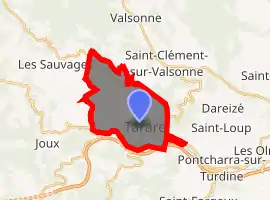Tarare
Tarare is a commune in the Rhône department in eastern France. It lies on the Turdine river, 28 miles west-northwest of Lyon by rail.
Tarare | |
|---|---|
.JPG.webp) The road into Tarare | |
.svg.png.webp) Coat of arms | |
Location of Tarare 
| |
 Tarare  Tarare | |
| Coordinates: 45°53′49″N 4°26′02″E | |
| Country | France |
| Region | Auvergne-Rhône-Alpes |
| Department | Rhône |
| Arrondissement | Villefranche-sur-Saône |
| Canton | Tarare (chef-lieu) |
| Intercommunality | CA de l'Ouest Rhodanien |
| Government | |
| • Mayor (2020–2026) | Bruno Peylachon |
| Area 1 | 13.99 km2 (5.40 sq mi) |
| Population (2017-01-01)[1] | 10,582 |
| • Density | 760/km2 (2,000/sq mi) |
| Time zone | UTC+01:00 (CET) |
| • Summer (DST) | UTC+02:00 (CEST) |
| INSEE/Postal code | 243 69 243 /69 170 |
| Elevation | 069–000 m (226–0 ft) (avg. 420 m or 1,380 ft) |
| 1 French Land Register data, which excludes lakes, ponds, glaciers > 1 km2 (0.386 sq mi or 247 acres) and river estuaries. | |
History
The city was founded at the beginning of the 12th century, as the priory of Tarare by the Savigny Abbey. Only weavers, shoemakers and tanners lived there, in addition to a few merchants and innkeepers.[2] In the 16th century, plagues decimated the population to the point that the consulate of Lyon initiated a special quest to aid the people in Tarare.[3]
Economy
A now archaic description of the early 20th-century economy is provided by the Encyclopædia Britannica Eleventh Edition:
Tarare is the centre of a region engaged in the production of muslins, tarletans, embroidery and silk-plush, and in printing, bleaching and other subsidiary processes. Till 1756, when the manufacture of muslins was introduced from Switzerland, the town lay unknown among the Beaujolais mountains. The manufacture of Swiss cotton yarns and crochet embroideries was introduced at the end of the 18th century; at the beginning of the 19th figured stuffs, openworks and zephyrs were first produced. The manufacture of silk-plush for hats and machine-made velvets was set up towards the end of the 19th century. A busy trade is carried on in corn, cattle, linen, hemp, thread and leather.[4]
Nearby villages
References
- "Populations légales 2017". INSEE. Retrieved 6 January 2020.
- Commission mixte des affaires culturelles tarare, société d'histoire et d'archéologie des monts de tarare (1985). Tarare : Des origines à nos jours - Commission Mixte Des Affaires Culturelles Tarare, Société D'Histoire Et D'Archéologie Des Monts De Tarare (in French). p. 31.
- MM. E. de Rolland; D. Clouzet (1901–1902). "Dictionnaire illustré des communes du département du Rhône" (in French). A. Storck & Cie. p. 544.
-
 One or more of the preceding sentences incorporates text from a publication now in the public domain: Chisholm, Hugh, ed. (1911). "Tarare". Encyclopædia Britannica. 26 (11th ed.). Cambridge University Press. p. 416.
One or more of the preceding sentences incorporates text from a publication now in the public domain: Chisholm, Hugh, ed. (1911). "Tarare". Encyclopædia Britannica. 26 (11th ed.). Cambridge University Press. p. 416.